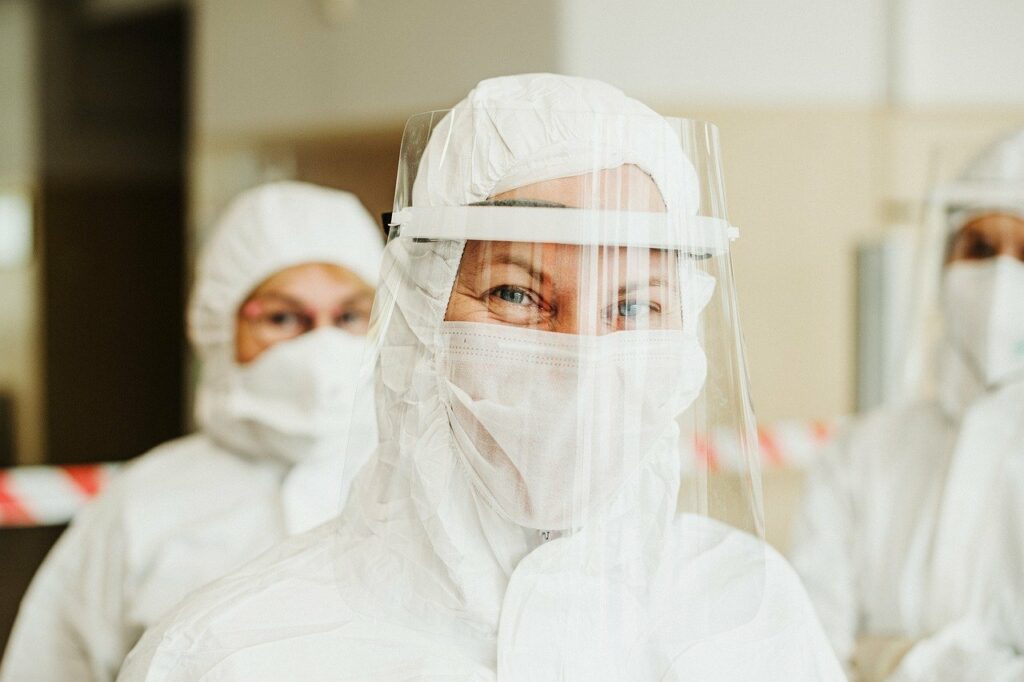Medically reviewed by West Texas Eye Associates Medical Staff

That’s right! March is Workplace Eye Wellness Month, highlighting the importance of protecting your vision at work. From construction to office settings, eye injuries are common but preventable with the right PPE. This guide covers high-risk jobs, hazards, and tips to keep your eyes safe. Let’s dive in!
The Prevalence of Workplace Eye Injuries
Workplace eye injuries may seem like a relic of the past, but they’re more common than most people realize. In 2020 alone, the U.S. Bureau of Labor Statistics1 (BLS) reports that American workers experienced 18,510 eye-related injuries or illnesses serious enough to require time off.
Construction trades workers experienced the most workplace eye injuries, followed closely by material moving workers. People who work in pest control, production, and metal and plastic manufacturing are also at risk of eye injuries. These employees often encounter chemicals and other hazards during their daily activities.
Most workplace eye injuries occur when a worker’s eye comes into contact with objects or equipment. The second leading cause is exposure to harmful substances or environments, while violence by another animal or person is the third. Falls, slips, and trips are a distant fourth, affecting only a few hundred employees.
While the BLS doesn’t consider digital eye strain an injury, this issue affects a staggering number of employees. A 2022 literature review2 estimates that 78% of people suffered from DES during the COVID-19 pandemic as time spent on devices skyrocketed. The study also notes that the prevalence of myopia — also known as near-sightedness — increased to almost 50% during this period.
Why Certified Eye Protection Matters
Personal protective equipment (PPE) is essential in many work environments, but not just any pair of glasses will do. Choose certified eye protection that meets the American National Standards Institute’s ANSI/ISEA Z87.1 standards3.
This eye protection is designed to prevent injuries caused by:
- Impact
- Non-ionizing radiation
- Splashes from chemicals and other liquids
Some PPE also has Z87 markings, which means it has been tested and approved for specific circumstances. For instance, gear with a D4 marking is designed for dust use, while an X means it has anti-fog properties. These symbols can help you select the most appropriate eyewear for your job.
The type of PPE you need depends on your career and work environment. To help you choose the right protective gear, here’s a breakdown of common jobs at risk for eye injuries and the recommended PPE for each.
| Job/Industry | Common Eye Hazards | Recommended PPE |
| Construction Worker | Flying debris, sawdust, metal particles | Safety glasses with side shields, dust goggles, or impact-resistant goggles |
| Healthcare Professional | Bodily fluids, splashes, aerosols | Full-face shields, splash-resistant goggles, or prescription safety glasses with protective overlays |
| Metal/Plastic Worker | Sparks, flying chips, chemical splashes | Chemical splash goggles, welding helmets with protective lenses, and impact-resistant glasses |
| Pest Control Worker | Pesticides, chemical exposure | Safety goggles with chemical splash protection and full-face respirators when handling hazardous substances |
| Agricultural Worker | Pesticides, UV exposure, flying debris from equipment | Wraparound safety glasses with UV protection, chemical splash goggles |
| Office Worker | Digital eye strain, prolonged screen exposure | Blue light-blocking glasses, anti-glare screen protectors |
| Production/Assembly Worker | Metal shards, airborne particles, hazardous liquids | Impact-resistant safety glasses, goggles with side shields, or face shields |
| Electrician | Sparks, arc flashes, and exposure to intense light | Safety glasses with side shields, tinted or shaded safety goggles |
| Carpenter | Sawdust, wood splinters, and flying nails | Safety glasses with anti-fog properties, face shields for saw operation |
Failure to wear certified eye protection may have dire consequences. Severe injuries — like a piece of glass in the eye or a chemical burn — can permanently damage eyes and lead to vision loss. In some cases, employees may even be unable to return to work, affecting their income.
Workplace eye injuries harm businesses, too. The Occupational Safety and Health Administration (OSHA) estimates that these incidents cost approximately $300 million annually4 in worker’s compensation, reduced productivity, and medical expenses.
Actionable Tips for Workplace Eye Safety
The mere thought of an eye injury is enough to make many people feel queasy. The good news? According to OSHA, companies can prevent up to 90% of these injuries with basic safety practices.
Get started by performing regular risk assessments. Examine your team’s daily activities closely and identify potential hazards, such as flying metal or dim lighting.
Make sure every employee has access to the proper protective gear. This might include safety glasses, goggles, or face shields. For example, agricultural workers might need safety glasses to protect against pesticides, while nurses may prefer face shields to block patient sneezes.
Of course, just handing equipment to your team isn’t enough. You should also provide training on proper eye safety practices. These educational programs typically take just a few minutes but can go a long way to preparing your employees to protect their eye health.
Are You Protecting Your Eyes at Work? Check All That Apply:
☐ I wear ANSI-certified safety glasses or face shields.
☐ I understand the potential eye hazards in my workplace.
☐ I follow the 20-20-20 rule when working with screens.
☐ My workplace provides proper training on eye protection.
☐ I schedule annual eye exams to monitor my vision.
If you left any boxes unchecked, it’s time to take steps to protect your eyes!
Office workers need protection, too. Encourage them to follow the 20-20-20 rule5: take a 20-second break to look at an object 20 feet away every 20 minutes. This simple step can reduce the risk of digital eye strain and headaches.
Need guidance on protecting your vision? Contact West Texas Eye Associates to schedule an eye exam and learn more about workplace eye wellness!
Protect Your Eyesight Year-Round
Prioritize eye injury prevention in March and beyond. You can make a difference in your workplace by following safety protocols and sharing the message of eye wellness with your colleagues.
Regular vision screenings can help you safeguard your eye health outside of work.
Sources
- Bureau of Labor Statistics. “Workers Suffered 18,510 Eye-Related Injuries and Illnesses in 2020.” https://www.bls.gov/opub/ted/2023/workers-suffered-18510-eye-related-injuries-and-illnesses-in-2020.htm.
- National Center for Biotechnology Information (NCBI). “Eye Safety: A Review of Workplace Injury Studies.” https://pmc.ncbi.nlm.nih.gov/articles/PMC9434525/.
- ANSI Blog. “ANSI/ISEA Z87.1-2020: Safety Glasses and Eye Protection.” https://blog.ansi.org/ansi-isea-z87-1-2020-safety-glasses-eye-protection/.
- American Academy of Ophthalmology (AAO). “Eye Injuries at Work: Tips for Prevention.” https://www.aao.org/eye-health/tips-prevention/injuries-work.
- Cleveland Clinic. “Eye Strain: Causes, Symptoms, Prevention, and Treatment.” https://my.clevelandclinic.org/health/diseases/21059-eye-strain.
